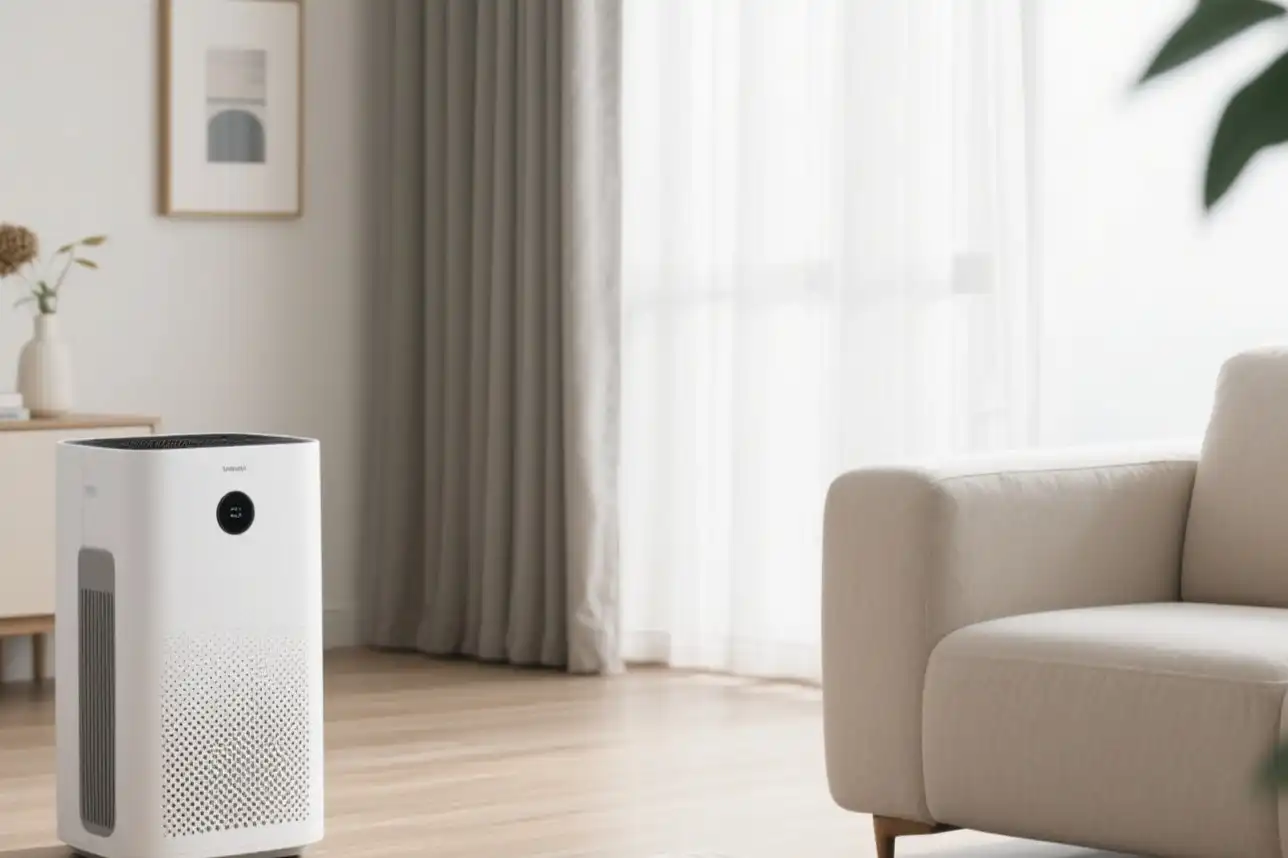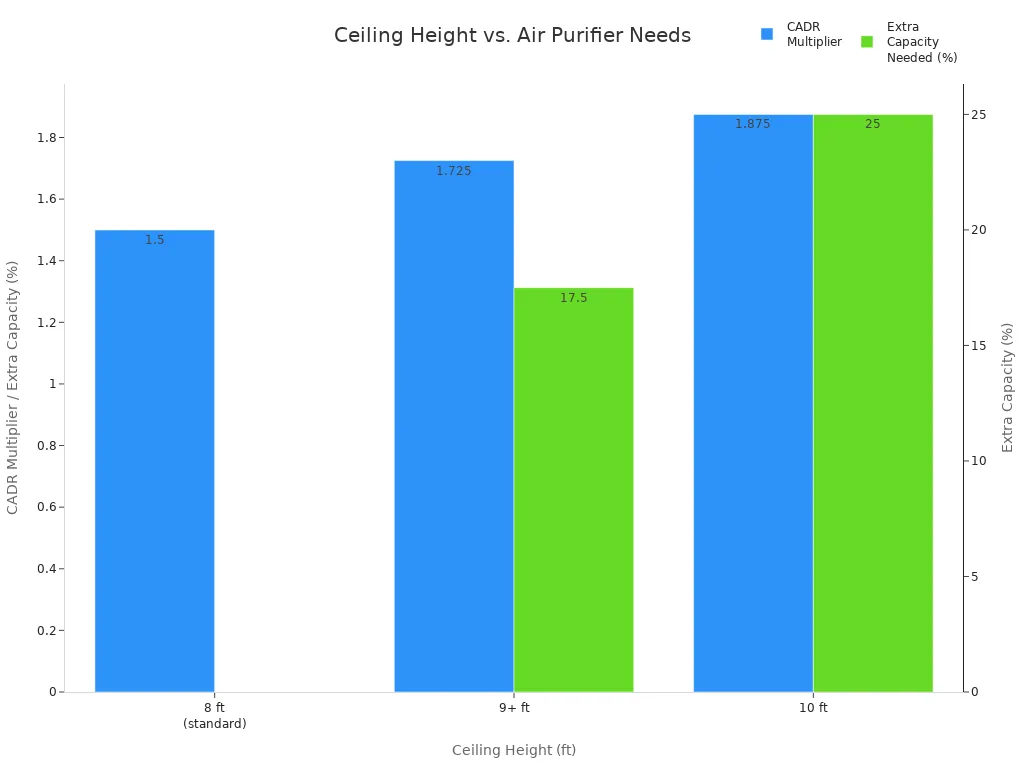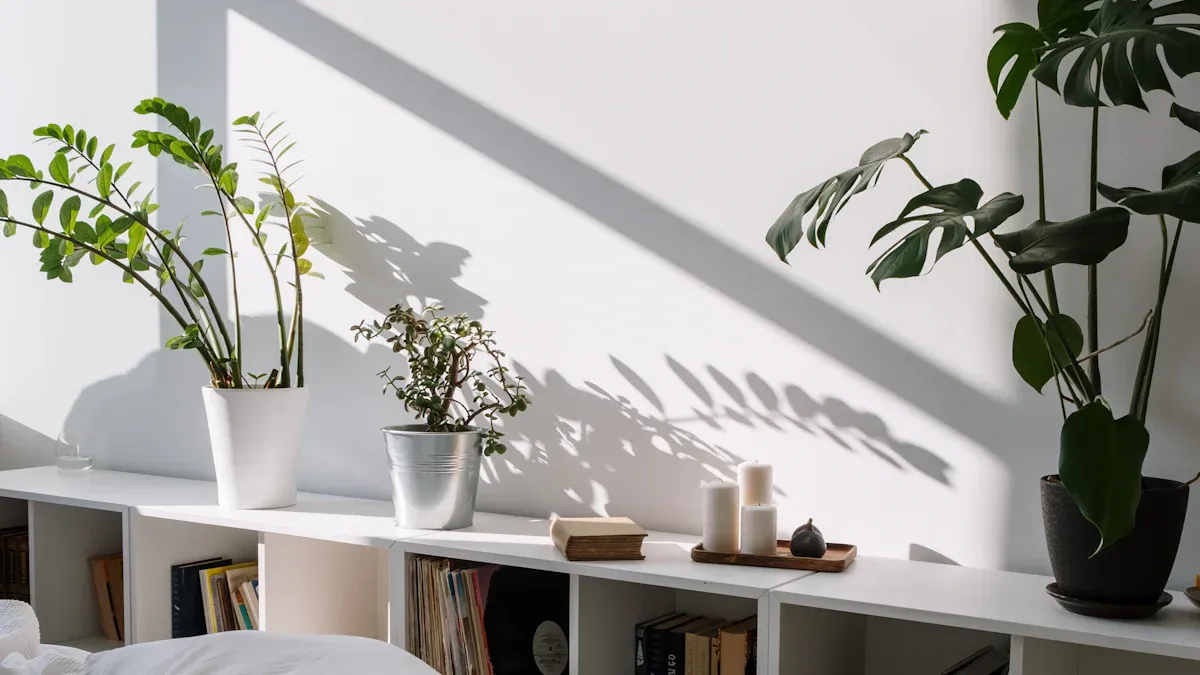
One air purifier may not always clean the air in more than one room well. You need to think about the size of your rooms, the way air moves through your home, and the power of your device. For example, if you have open doorways, air can flow between rooms, but this can also let pollutants move around. Placing your air purifier in the right spot and matching its clean air delivery rate to your space helps you get better results.
Key Takeaways
- One air purifier might not clean many rooms well. It needs to fit your home’s size and shape.
- Look at the purifier’s Clean Air Delivery Rate (CADR). Also, check the room size. This helps you choose the right purifier for your space.
- Open floor plans let one purifier clean more air. Closed rooms often need their own purifiers.
- Put your purifier away from walls and furniture. The best spot is in the middle of the room. Place it where you spend most of your time.
- Using more than one purifier in different rooms works better. This gives you cleaner air and faster results.
Air Purifier Coverage
.Air-Purifier-Coverage-1024x683.webp)
When you choose an air purifier for your home, you need to know how much space it can clean. The coverage depends on three main things: the size of your room, the layout and doors, and the purifier’s capacity. Understanding these factors helps you pick the right device for your needs.
Room Size
Room size is the first thing you should check. Manufacturers use a measurement called Clean Air Delivery Rate (CADR) to show how much clean air the purifier can deliver. You can use CADR to estimate the coverage area. For example, multiply the CADR by 1.55 to get the square footage the purifier can handle. If your room is 200 square feet, you need a CADR of at least 133.
Tip: Always check the room’s ceiling height. Standard coverage assumes an 8-foot ceiling. If your ceiling is higher, you need a stronger purifier. For a 10-foot ceiling, you should increase the purifier’s capacity by about 25%.

Here is a quick guide for room sizes:
- Small rooms (bathroom, small bedroom): about 200 sq ft
- Medium rooms (den, small basement): 201–399 sq ft
- Large rooms (living room, master bedroom): 400+ sq ft
Layout and Doors
The way your rooms connect changes how well an air purifier works. Open floor plans let air move freely, so one purifier can clean a larger area. If you have walls and closed doors, air cannot flow as easily. This means the purifier cannot clean air in other rooms very well.
- Open doors help air move between rooms, but closed doors block airflow.
- Placing the purifier in the center of an open space works best.
- Avoid putting the purifier behind furniture or close to walls, because this blocks airflow and lowers performance.
If your home has many separate rooms, you may need more than one purifier for good coverage.
Capacity Ratings
You should always match the purifier’s capacity to your space. The Association of Home Appliance Manufacturers (AHAM) suggests that the smoke CADR rating should be at least two-thirds of your room’s square footage. For example, a 150-square-foot room needs a smoke CADR of at least 100.
| Room Size Description | Approximate Room Area (sq ft) | Typical CADR Range (smoke) |
|---|---|---|
| Small rooms (single room) | Up to 100 | 100 – 150 |
| Mid-sized rooms (multiple rooms or larger single rooms) | Around 200 | 200 – 300 |
| Large or open concept rooms | Larger than 200 | 300+ |
If your room has high ceilings, you need to adjust the purifier’s capacity upward. Use this formula to check if your purifier is strong enough:
Maximum Room Size = (CFM × 60) / (ACH × Ceiling Height)
You should also look for AHAM certification to make sure the purifier meets industry standards. This helps you compare different models and choose the best one for your needs.
Multi-Room Effectiveness

Open vs. Separated Spaces
You might wonder if one air purifier works for both open and closed rooms. The way your home is set up changes how air moves and how well the purifier works.
- In open spaces, air moves easily. Pollutants from places like the kitchen can travel far, even up to 30 feet. This means cooking smells or smoke can quickly reach other rooms.
- Open doorways let about half to three-fourths of the air move between rooms. This helps the purifier clean more space, but it also lets pollution spread faster.
- In homes with open layouts, you may see “pollution plumes.” These are clouds of dirty air that move from one area to another. This makes it hard for one purifier to keep up.
If you have rooms with closed doors, the purifier cannot clean those spaces. Even if doors are open, the way the rooms are built can block air. You might notice that bedrooms or bathrooms have stale air or smell different from other rooms.
Tip: Put your purifier where air can move around it. Do not place it right next to walls or big furniture. This helps the purifier pull in and clean air better.
Limitations of One Unit
Using just one air purifier for many rooms can be hard. Each room has its own air problems.
- Bathrooms can have lots of moisture and mold spores.
- Kitchens make gases like nitrogen dioxide and carbon monoxide, plus tiny cooking particles.
- Living rooms may have dust, smoke, and chemicals from furniture or fireplaces.
- Children’s rooms can have allergens and chemicals from toys.
One purifier may not clean all these things at once. You also need to think about how people use each room. Some rooms, like living rooms, have more people at certain times. This changes how much pollution is in the air.
- One purifier must be strong enough for all the connected rooms. If it is too weak, it cannot clean the air well.
- You should put the purifier near the edges between rooms to help stop pollution from spreading.
- Multi-stage filters, like HEPA and activated carbon, work better for homes with many types of pollution. Some purifiers have sensors that change how hard they work as air quality changes.
Studies show that one unit often cannot keep every room clean. In homes with separate rooms, it is better to use a portable purifier in each space. You can also move a portable purifier to the room you use most during the day. For the best results, many people use more than one purifier in different rooms at the same time.
Note: If you see dust, smell odors, or have allergy problems in some rooms, your purifier may not cover the whole area. Adding more purifiers or moving your purifier can help make the air better.
Air Purifier Types
Single-Room Models
Single-room models clean the air in just one room. These devices work best in bedrooms, offices, or small living rooms. You can find them with HEPA filters, activated carbon, UV-C light, or ionization. Each type helps remove different things, like dust, smoke, or smells. Most single-room purifiers are easy to move and set up. You can use them where you need clean air most. But they only work in one room at a time. If you try to use one for many rooms, some spots may still have dust or bad smells. The purifier might also use more energy if it tries to clean too much space.
Tip: If you have allergies or want clean bedroom air, a single-room model is a good pick.
Whole-House Options
Whole-house air purifiers clean the air in every room. These systems connect to your home’s HVAC system. They filter all the air that moves through your heating and cooling ducts. Whole-house options use strong filters, like HEPA or activated carbon, and sometimes UV light. This setup removes dust, pollen, gases, and even germs from the air. You get steady air quality in every room, which helps if you have asthma or allergies. These systems need professional installation and regular maintenance. They last longer and handle more air than portable units. You do not need to move them from room to room.
| Type | Coverage | Installation | Maintenance | Best For |
|---|---|---|---|---|
| Single-Room | One room | Plug-and-play | Easy, frequent | Bedrooms, offices |
| Whole-House | Entire home | Professional | Less frequent | Families, large homes |
Portability
Portability means you can move some air purifiers to different rooms. Most single-room models are light and have handles or wheels. You can put them where you need clean air most. This helps if you spend time in different rooms during the day. Portable purifiers cost less than whole-house systems and do not need special installation. You can set them up yourself. But you may need more than one for full coverage. Each device needs its own filter changes and takes up space. Some models can be noisy, especially on high settings.
- Advantages:
- Easy to move and set up
- Lower cost
- Good for targeted cleaning
- Disadvantages:
- Limited to one room at a time
- Multiple units needed for whole-home coverage
- Each unit needs separate maintenance
Note: Portable air purifiers are good for small spaces or if you want to try one before buying a whole-house system.
Assessing Your Needs
Measuring Spaces
Start by measuring each room where you want cleaner air. Use a tape measure or a laser tool to find the length, width, and ceiling height. Multiply these numbers to get the room’s volume. For example, a room that is 12 feet long, 10 feet wide, and 8 feet high has a volume of 960 cubic feet. Next, decide how many air changes per hour (ACH) you want. Bedrooms often need 5-6 ACH, while living rooms may need 6-8 ACH. Use this formula to find the airflow you need:
CFM = (Room Volume × ACH) / 60
Add up the airflow needs for all rooms you want to purify. You can also use indoor air quality monitors in different rooms. These devices track pollutants like dust, VOCs, and CO2. Place monitors in bedrooms, kitchens, and basements to spot pollution trends and decide where you need the most help.
Placement Tips
Where you put your air purifier matters. Place it on a hard, flat surface, not on a thick rug. Keep it at least 12 inches away from walls or furniture. Avoid corners, since these block airflow. Put the purifier in the room where you spend the most time, such as your bedroom or living room. If you move between rooms during the day, consider moving the purifier with you. For homes with many rooms or floors, you may need more than one unit. Place extra purifiers in high-traffic areas or where pollution is highest, like kitchens or rooms with pets.
Tip: Run your purifier all day for the best results. Higher speeds clean more air but may use more energy.
Signs of Insufficient Coverage
You can spot when your air purifier is not enough for your space. Watch for these signs:
- Dust builds up quickly, even after cleaning.
- You notice musty or stale smells that do not go away.
- Family members keep sneezing, coughing, or have itchy eyes.
- The purifier makes odd noises or the filter clogs often.
- Your electric bill rises because the purifier works too hard.
If you see these problems, you may need to add more purifiers or check if your current unit matches your room size. Experts suggest having a purifier in each main living area, especially bedrooms and spaces with high pollution.
You can use one purifier in open areas or small houses if it is strong enough for the space and fits the room shape. If your house has many rooms, using more than one smaller purifier usually works better and cleans the air faster.
Experts say you should measure each room, check how tall the ceiling is, and keep purifiers away from corners or big furniture.
- People often make mistakes like picking the wrong filter size, putting the purifier in a bad spot, or not cleaning it often enough.
Do these things to help your home have the cleanest air it can.
FAQ
What does CADR mean for air purifiers?
CADR stands for Clean Air Delivery Rate. It tells you how much clean air your purifier can make each minute. You can use this number to match a purifier to your room size.
What happens if you use one purifier for too many rooms?
You may notice dust, smells, or allergy symptoms. One purifier cannot clean air in many rooms at once. You need to match the purifier’s power to your space for the best results.
What is the best place to put an air purifier?
Place your air purifier in the center of the room or near where you spend the most time. Keep it away from walls and large furniture. This helps air move freely and lets the purifier work better.
What signs show your air purifier is not enough?
- Dust builds up quickly
- Bad smells stay in the air
- People sneeze or cough often
If you see these signs, you may need a stronger or extra purifier.
See also
What to Consider Before Putting an Air Purifier in Every Room
How many air purifiers are needed for different room sizes
